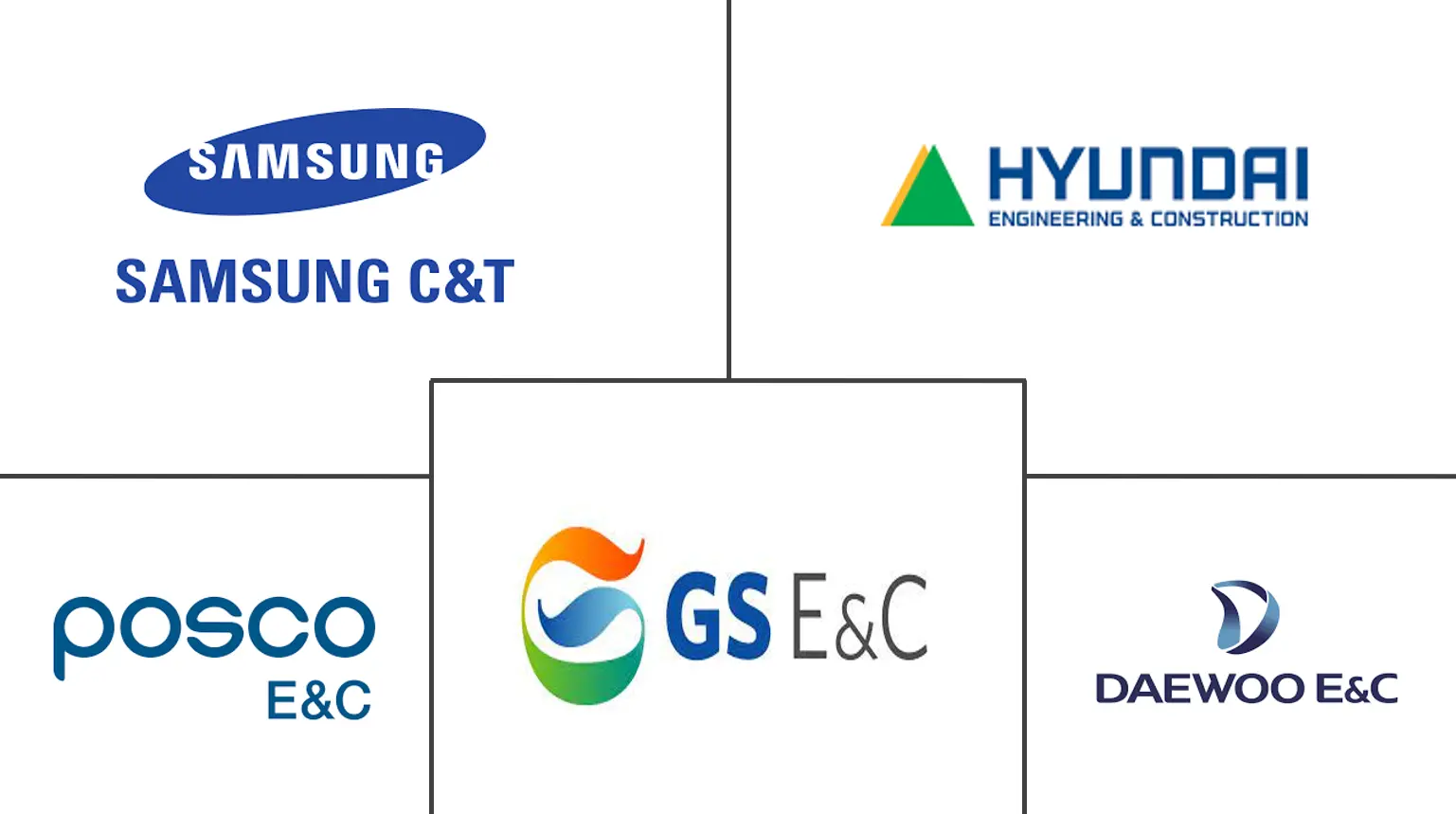Market Size of South Korea Construction Industry

| Study Period | 2020 - 2029 |
| Base Year For Estimation | 2023 |
| Forecast Data Period | 2024 - 2029 |
| Historical Data Period | 2020 - 2022 |
| CAGR | 4.05 % |
| Market Concentration | Low |
Major Players
*Disclaimer: Major Players sorted in no particular order |
South Korea Construction Market Analysis
The size of the South Korea construction market is USD 130 billion in the current year and is anticipated to register a CAGR of over 4.05% during the forecast period
- COVID-19 had a significant impact on the construction industry in South Korea, with supply chain issues, a halt to planning and inspection timelines, and new measures to ensure worker health and safety.
- Following a 1.4% decline in 2020, the South Korean construction industry contracted by 1.4% in 2021. The downward revision was due to increased COVID-19 infection rates, a drop in construction output in the first three quarters of 2021, and disruptions in construction activity.
- The construction industry's value add decreased by 0.9% year on year (Y-o-Y) in real terms in the third quarter of 2021, according to the Korean Statistical Information Service (KOSIS), following a decline of 3.4% in the second quarter and growth of 3.2% in the first.
- In February 2021, the government announced that it would build 830,000 houses across the country over the next four years, with 323,000 in Seoul and 293,000 in nearby Gyeonggi Province and Incheon.
- In 2022, the industry recovered, growing by 4.1%, due to significant spending outlined in the proposed budget for 2022 and the implementation of planned energy projects.
South Korea Construction Industry Segmentation
Construction is a general term meaning the art and science of forming objects, systems, or organizations. Construction is an industry that includes the erection, maintenance, and repair of buildings and other immobile structures and the building of roads and service facilities that become integral parts of structures and are essential to their use.
The South Korean construction market is segmented by sector (residential construction, commercial construction, industrial construction, infrastructure (transportation) construction, and energy and utilities construction). The report offers market size and forecasts for the South Korean construction market in value (USD billion) for all the above segments.
| By Sector | |
| Residential Construction | |
| Commercial Construction | |
| Industrial Construction | |
| Infrastructure (Transportation) Construction | |
| Energy and Utilities Construction |
South Korea Construction Market Size Summary
The construction market in South Korea is experiencing a gradual recovery and growth trajectory following the disruptions caused by the COVID-19 pandemic. The industry faced significant challenges, including supply chain issues and delays in planning and inspections, which led to a contraction in 2020 and 2021. However, government initiatives, such as the announcement to construct a substantial number of housing units, and increased budget allocations for energy projects, have spurred recovery. The market is characterized by a high volume of residential and commercial building permits, with Gyeonggi province leading in housing construction. The real estate sector remains a crucial component of the economy, with significant contributions to GDP and a steady increase in commercial building stock over the years.
The South Korean construction market is moderately fragmented, with major players like Samsung C&T, Hyundai E&C, GS E&C, and Daewoo E&C dominating the landscape. These companies are actively engaging in innovative projects, such as modularizing carbon capture solutions and biodiesel production facilities, in collaboration with international partners. This focus on innovation and sustainability is indicative of the industry's adaptation to global trends and regulatory demands. The market's growth is further supported by the increasing number of real estate investment trusts (REITs) and the rising value of commercial properties, reflecting the sector's resilience and potential for future expansion.
South Korea Construction Market Size - Table of Contents
-
1. MARKET DYNAMICS AND INSIGHTS
-
1.1 Market Overview
-
1.2 Market Drivers
-
1.3 Market Opportunities
-
1.4 Market Restraints
-
1.5 Value Chain/Supply Chain Analysis
-
1.6 Porter's Five Forces Analysis
-
1.6.1 Threat of New Entrants
-
1.6.2 Bargaining Power of Buyers/Consumers
-
1.6.3 Bargaining Power of Suppliers
-
1.6.4 Threat of Substitute Products
-
1.6.5 Intensity of Competitive Rivalry
-
-
1.7 Current Economic and Construction Market Scenario
-
1.8 Technological Innovations in the Construction Sector
-
1.9 Impact of Government Regulations and Initiatives on the Industry
-
1.10 Impact of COVID - 19 on the Market
-
-
2. MARKET SEGMENTATION
-
2.1 By Sector
-
2.1.1 Residential Construction
-
2.1.2 Commercial Construction
-
2.1.3 Industrial Construction
-
2.1.4 Infrastructure (Transportation) Construction
-
2.1.5 Energy and Utilities Construction
-
-
South Korea Construction Market Size FAQs
What is the current South Korea Construction Market size?
The South Korea Construction Market is projected to register a CAGR of greater than 4.05% during the forecast period (2024-2029)
Who are the key players in South Korea Construction Market?
Samsung C&T, Hyundai E&C, GS E&C, Daewoo E&C and POSCO E&C are the major companies operating in the South Korea Construction Market.

